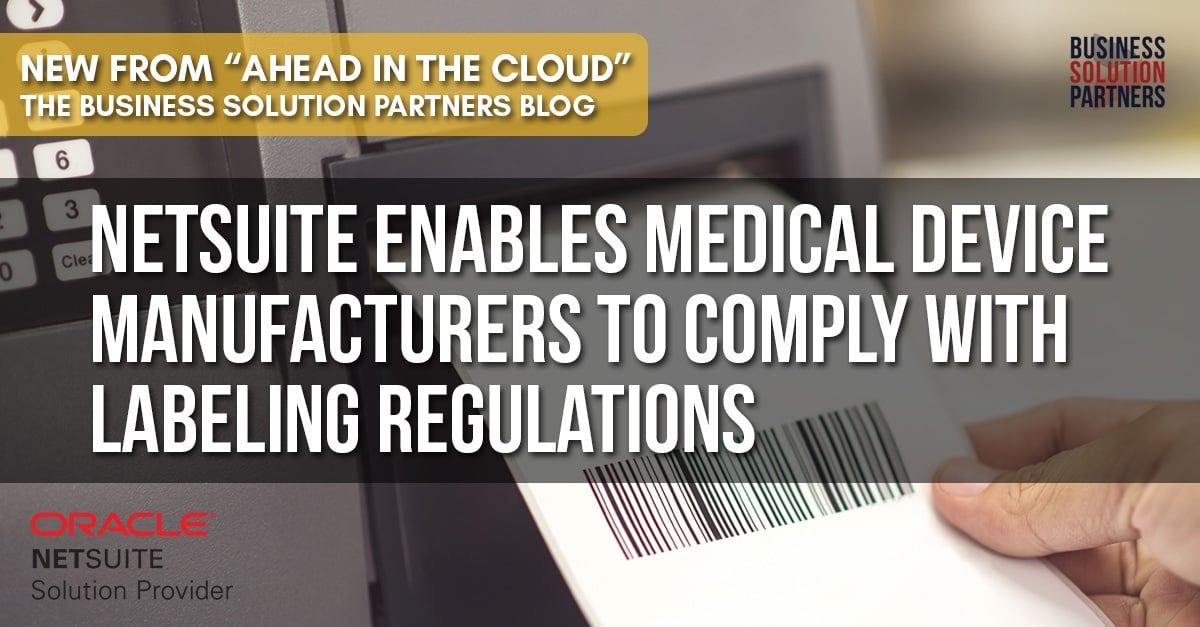Advantages of Cloud ERP vs. OnPrem Solutions for the Medical Device Industry
Aging populations around the world have underpinned the growth in the medical device industry in recent years. KPMG forecasts that this trend will...
5 min read
![]() Business Solution Partners
:
Feb 29, 2024 11:45:00 AM
Business Solution Partners
:
Feb 29, 2024 11:45:00 AM

Medical Device Manufacturers know... All processes associated with designing, manufacturing, packaging, labeling, storing, installing, or servicing a finished device intended for human use must be validated.
The FDA defines process validation as:
”the collection and evaluation of data, from the process design stage through commercial production, which establishes scientific evidence that a process is capable of consistently delivering quality product.”
The FDA also mandates that software used for the design, manufacture, packaging, labelling, storage, installation, and servicing of all finished devices intended for human use shall be validated.
"(a) Where the results of a process cannot be fully verified by subsequent inspection and test, the process shall be validated with a high degree of assurance and approved according to established procedures. The validation activities and results, including the date and signature of the individual(s) approving the validation and where appropriate the major equipment validated, shall be documented.
(b) Each manufacturer shall establish and maintain procedures for monitoring and control of process parameters for validated processes to ensure that the specified requirements continue to be met.
(1) Each manufacturer shall ensure that validated processes are performed by qualified individual(s).
(2) For validated processes, the monitoring and control methods and data, the date performed, and, where appropriate, the individual(s) performing the process or the major equipment used shall be documented.
(c) When changes or process deviations occur, the manufacturer shall review and evaluate the process and perform revalidation where appropriate. These activities shall be documented."
https://www.accessdata.fda.gov/scripts/cdrh/cfdocs/cfcfr/CFRSearch.cfm?fr=820.75
Validation continues with the Global Harmonization Task Force (GHTF) Guidance: Quality Management System Medical Devices – Process Validation Guidance, SG3; 2004. This document is non-binding guidance to regulatory authorities for use in the regulation of medical devices. In fact, the GHTF is often consulted by those who create the regulations that govern the industry.
First, it is wise to have a Master Validation Plan. The purpose of a Master Validation Plan is to outline what needs to be done to successfully obtain process validation.
It is important to remember that although a Master Validation Plans is not a specific Code of Federal Regulations (CFR) section 820 requirement, it is recommended as per GHTF Guidance.
The plan should:
GHTF guidance also strongly recommends that you have:
Simply put, Installation Qualification (IQ) asks the question: “Is everything installed correctly?” In answering this question, you should consider the following:
Operational Qualification (OQ) challenges the process parameters to assure that the process will result in a product that meets requirements. The factors to consider are:
Finally, you need to consider Performance Qualification (PQ). You must demonstrate that the process will consistently produce an acceptable product under normal operating conditions. Things to consider:
After you qualify the installation, operation and performance that GHTF strongly suggests, you next have to ensure that you have the following required documentation:
If there have been changes or process deviations, then re-validation is necessary.
As stated in 21 CFR 820.75(c):
When changes or process deviations occur, the manufacturer shall review and evaluate the process and perform revalidation where appropriate. These activities shall be documented.
Some examples of reasons for revalidation are as follows:
In highly regulated industries, such as in the medical device field, best practices practically demand having a program such as Oracle’s NetSuite. The sheer quantity of validation regulations (which differ in each country!) virtually scream out for the solutions that NetSuite offers.
To best see how NetSuite can successfully overcome these challenges and open up profitable opportunities for your enterprise, contact Business Solution Partners - your NetSuite Certified Partner Solution Provider.

Aging populations around the world have underpinned the growth in the medical device industry in recent years. KPMG forecasts that this trend will...

The primary objective of Medical Device labeling is to ensure that patients in need, and practitioners providing care, can access clear, accurate and...
With the rise of labor costs and globalization of the economy, many fear the decline and fall of American manufacturing. Symptomatic of these...